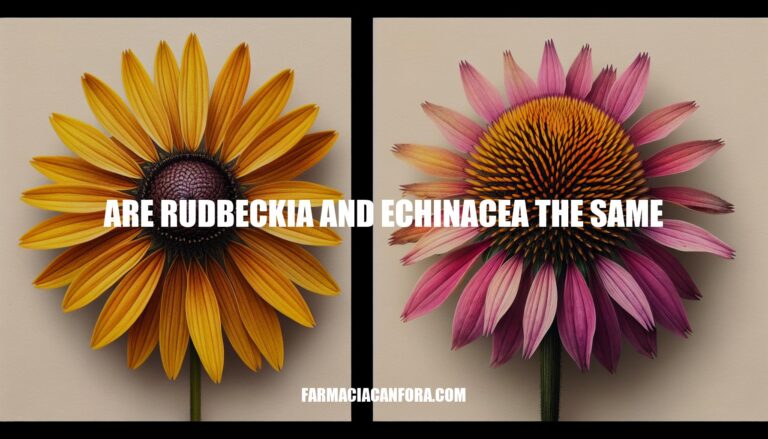Are Rudbeckia and Echinacea the same? This is a common question among gardeners and plant enthusiasts. Both plants belong to the Asteraceae family and share similar daisy-like flowers, which often leads to confusion. However, despite their similarities, Rudbeckia (commonly known as Black-eyed Susan) and Echinacea (commonly known as Coneflower) are distinct genera with unique characteristics. Understanding these differences can help in identifying and cultivating them effectively.
Botanical Classification
Rudbeckia and Echinacea are both part of the Asteraceae family, commonly known as the daisy or sunflower family. However, they belong to different genera:
- Rudbeckia: This genus includes around 25 species. These plants are often referred to as coneflowers and are known for their bright yellow or orange flowers with a prominent central cone.
- Echinacea: This genus comprises about 10 species. Echinacea plants, also called coneflowers, typically have purple or pink flowers and are well-known for their medicinal properties.
Despite their similarities and close relation within the Asteraceae family, they are distinct in their genus classification.
Physical Differences
Rudbeckia:
- Flower Color: Typically yellow or orange with a dark brown or black center.
- Shape: Petals grow outward from the center.
- Size: Generally smaller flowers compared to Echinacea.
Echinacea:
- Flower Color: Often pink, purple, or white with a dark center.
- Shape: Petals tend to curve downward and outward from the center.
- Size: Slightly larger flowers, sometimes requiring support due to the weight of the flower heads.
Growth Habits
Let’s dive into the growth habits and environmental preferences of Rudbeckia and Echinacea.
Rudbeckia (Black-eyed Susan)
- Growth Habits: Rudbeckia typically grows to about 2-3 feet tall. It has a clump-forming habit and can spread more vigorously compared to Echinacea. The flowers have bright yellow petals with a dark brown or black center, and they stand upright.
- Environmental Preferences: Rudbeckia thrives in full sun but can tolerate partial shade. It prefers well-drained soil and is quite adaptable to various soil types, including clay and loam. Rudbeckia is also more tolerant of cooler climates.
Echinacea (Coneflower)
- Growth Habits: Echinacea grows to a height of 2-4 feet and has a more compact, clump-forming habit. The flowers have a prominent cone-shaped center, often brown or orange, with petals that droop downwards, giving them a relaxed appearance.
- Environmental Preferences: Echinacea prefers full sun and well-drained soil. It is drought-tolerant once established and can handle a variety of soil types, though it thrives best in sandy or loamy soils. Echinacea is slightly larger and less tolerant of cooler climates compared to Rudbeckia.
Key Differences
- Flower Structure: Rudbeckia’s petals stand straight out, while Echinacea’s petals droop downwards.
- Climate Tolerance: Rudbeckia is more tolerant of cooler climates, whereas Echinacea prefers slightly warmer conditions.
- Growth Spread: Rudbeckia can spread more vigorously, while Echinacea tends to stay more compact.
Both plants are excellent for attracting pollinators and are relatively low-maintenance, making them great additions to any garden.
Uses in Gardening
Rudbeckia and Echinacea are both popular choices in gardening due to their vibrant colors, hardiness, and ability to attract pollinators. Here’s how they can be used and what makes them distinct:
Rudbeckia (Black-Eyed Susan)
- Uses:
- Borders and Mass Plantings: Their bright yellow, orange, and red flowers create a striking visual impact.
- Pollinator Gardens: Attracts bees, butterflies, and other beneficial insects.
- Cut Flowers: Long-lasting blooms make excellent cut flowers.
- Characteristics:
- Flower Shape: Daisy-like flowers with a dark central cone.
- Bloom Time: Late summer to fall.
- Growth Habit: Typically grows 2-3 feet tall, forming clumps.
- Hardiness: Tolerates a range of soil types and is drought-resistant once established.
Echinacea (Coneflower)
- Uses:
- Mixed Borders: Adds height and color with its tall stems and large, vibrant flowers.
- Wildflower Meadows: Blends well with other native plants.
- Medicinal Gardens: Known for its immune-boosting properties.
- Cut Flowers: Sturdy stems and long-lasting blooms.
- Characteristics:
- Flower Shape: Cone-shaped flowers with spiky centers, usually in shades of pink, purple, and white.
- Bloom Time: Mid-summer to early fall.
- Growth Habit: Can grow up to 4 feet tall, with a more upright form.
- Hardiness: Prefers well-drained soil and full sun, drought-tolerant.
Design Considerations
- Color and Texture: Rudbeckia’s warm tones and daisy-like flowers contrast beautifully with Echinacea’s cooler tones and spiky centers, creating a dynamic and visually appealing garden.
- Height and Structure: Use Rudbeckia for mid-height plantings and Echinacea for taller accents, adding depth and layers to garden designs.
- Seasonal Interest: Both plants bloom at different times, ensuring continuous color and interest throughout the growing season.
By combining these plants, gardeners can create diverse and vibrant landscapes that support pollinators and provide visual interest from mid-summer through fall.
Rudbeckia and Echinacea: Understanding the Differences
Rudbeckia and Echinacea are not the same, despite their similarities in appearance. They belong to different genera within the Asteraceae family and have distinct characteristics.
Rudbeckia is known for its bright yellow or orange flowers with a dark central cone, while Echinacea has purple or pink flowers with a prominent cone-shaped center.
The two plants also differ in growth habits, environmental preferences, and design considerations. Rudbeckia can spread more vigorously and prefers cooler climates, whereas Echinacea tends to stay compact and prefers warmer conditions.
By understanding these differences, gardeners can effectively identify and cultivate each plant, creating diverse and vibrant landscapes that support pollinators and provide visual interest throughout the growing season.


